Biochar/Clay Composite Particle Immobilized Compound Bacteria: Preparation, Collaborative Degradation Performance and Environmental Tolerance
Abstract
:1. Introduction
2. Materials and Methods
2.1. Preparation of BCCP
2.2. Flavobacterium mizutaii sp. and Aquamicrobium sp.
2.3. Adsorption kinetics of NH4+–N by BCCP
2.4. Preparation of Immobilized Compound Bacteria
2.5. Degradation of NH4+–N and PHCs by Immobilized Compound Bacteria
2.6. Tolerances of Low Temperature and High Salinity
2.7. Analysis Methods
3. Results
3.1. Preparation and Condition Optimization of BCCP
3.1.1. Effect of Preparation Formula on the Adsorption Characteristics of NH4+–N
3.1.2. Effect of Raw Material Ratio on NH4+–N Adsorption
3.2. Performances of Individual AOB and Petroleum-Degrading Bacteria Immobilization
3.2.1. NH4+–N Removal Performance with Immobilized Flavobacterium mizutaii sp.
3.2.2. The Effect of Immobilized Aquamicrobium sp. on the Removal of PHCs
3.3. Performance of Immobilized Compound Bacteria
3.4. Tolerance of Immobilized Compound Bacteria to Low Temperature and High Salinity
3.4.1. Tolerance to Temperature
3.4.2. Tolerance to Salinity
3.5. NH4+–N and PHCs Degradation Mechanism with BCCP Immobilization
4. Conclusions
Author Contributions
Funding
Data Availability Statement
Conflicts of Interest
References
- Saha, T.K.; Pal, S. Exploring physical wetland vulnerability of Atreyee river basin in India and Bangladesh using logistic regression and fuzzy logic approaches. Ecol. Indic. 2018, 98, 251–265. [Google Scholar] [CrossRef]
- Duan, M.; Li, C.; Wang, X.; Fang, S.; Xiong, Y.; Shi, P. Solid separation from the heavy oil sludge produced from Liaohe Oilfield. J. Pet. Sci. Eng. 2018, 172, 1112–1119. [Google Scholar] [CrossRef]
- Huang, X.; Bai, J.; Li, K.; Zhao, Y.; Tian, W.; Hu, C. Preparation of Clay/Biochar Composite Adsorption Particle and Performance for Ammonia Nitrogen Removal from Aqueous Solution. J. Ocean Univ. China 2020, 19, 729–739. [Google Scholar] [CrossRef]
- Chen, Y.; Wang, X.; Wang, X.; Cheng, T.; Fu, K.; Qin, Z.; Feng, K. Biofilm Structural and Functional Features on Microplastic Surfaces in Greenhouse Agricultural Soil. Sustainability 2022, 14, 7024. [Google Scholar] [CrossRef]
- Shahi, A.; Aydin, S.; Ince, B.; Ince, O. Evaluation of microbial population and functional genes during the bioremediation of petroleum-contaminated soil as an effective monitoring approach. Ecotoxicol. Environ. Saf. 2016, 125, 153–160. [Google Scholar] [CrossRef] [PubMed]
- Sun, P.; Huang, X.; Xing, Y.; Dong, W.; Yu, J.; Bai, J.; Duan, W. Immobilization of Ochrobactrum sp. on Biochar/Clay Composite Particle: Optimization of Preparation and Performance for Nitrogen Removal. Front. Microbiol. 2022, 13, 838836. [Google Scholar] [CrossRef]
- He, H.; Chen, Y.; Li, X.; Cheng, Y.; Yang, C.; Zeng, G. Influence of salinity on microorganisms in activated sludge processes: A review. Int. Biodeterior. Biodegradation 2016, 119, 520–527. [Google Scholar] [CrossRef]
- Nwoba, E.G.; Parlevliet, D.A.; Laird, D.W.; Alameh, K.; Moheimani, N.R. Light management technologies for increasing algal photobioreactor efficiency. Algal Res. 2019, 39, 101433. [Google Scholar] [CrossRef]
- Angelim, A.L.; Costa, S.P.; Farias, B.C.S.; Aquino, L.F.; Melo, V.M.M. An innovative bioremediation strategy using a bacterial consortium entrapped in chitosan beads. J. Environ. Manag. 2013, 127, 10–17. [Google Scholar] [CrossRef]
- Reddy, S.; Osborne, J.W. Biodegradation and biosorption of Reactive Red 120 dye by immobilized Pseudomonas guariconensis: Kinetic and toxicity study. Water Environ. Res. 2020, 92, 1230–1241. [Google Scholar] [CrossRef]
- Yan, H.; Han, Z.; Zhao, H.; Pan, J.; Zhao, Y.; Tucker, M.E.; Zhou, J.; Yan, X.; Yang, H.; Fan, D. The bio-precipitation of calcium and magnesium ions by free and immobilized Lysinibacillus fusiformis DB1-3 in the wastewater. J. Clean. Prod. 2019, 252, 119826. [Google Scholar] [CrossRef]
- Huang, X.; Bai, J.; Li, K.-R.; Zhao, Y.-G.; Tian, W.-J.; Dang, J.-J. Characteristics of two novel cold- and salt-tolerant ammonia-oxidizing bacteria from Liaohe Estuarine Wetland. Mar. Pollut. Bull. 2017, 114, 192–200. [Google Scholar] [CrossRef]
- Huang, X.; Zhou, T.; Chen, X.; Bai, J.; Zhao, Y. Enhanced Biodegradation of High-Salinity and Low-Temperature Crude-Oil Wastewater by Immobilized Crude-Oil Biodegrading Microbiota. J. Ocean Univ. China 2022, 21, 141–151. [Google Scholar] [CrossRef]
- Mahdi, Z.; Yu, Q.J.; El Hanandeh, A. Removal of lead(II) from aqueous solution using date seed-derived biochar: Batch and column studies. Appl. Water Sci. 2018, 8, 181. [Google Scholar] [CrossRef]
- Ojeda-López, R.; Ramos-Sánchez, G.; García-Mendoza, C.; Azevedo, D.C.S.; Guzmán-Vargas, A.; Felipe, C. Effect of Calcination Temperature and Chemical Composition of PAN-Derived Carbon Microfibers on N2, CO2, and CH4 Adsorption. Materials 2021, 14, 3914. [Google Scholar] [CrossRef] [PubMed]
- Xue, S.; Zhang, X.; Ngo, H.H.; Guo, W.; Wen, H.; Li, C.; Zhang, Y.; Ma, C. Food waste based biochars for ammonia nitrogen removal from aqueous solutions. Bioresour. Technol. 2019, 292, 121927. [Google Scholar] [CrossRef]
- Yao, Y.; Gao, B.; Fang, J.; Zhang, M.; Chen, H.; Zhou, Y.; Creamer, A.E.; Sun, Y.; Yang, L. Characterization and environmental applications of clay–biochar composites. Chem. Eng. J. 2014, 242, 136–143. [Google Scholar] [CrossRef]
- Ömeroğlu, A.; Erdoğan, Y.; Özcan, A.S. Modification of bentonite with a cationic surfactant: An adsorption study of textile dye Reactive Blue 19. J. Hazard. Mater. 2007, 140, 173–179. [Google Scholar] [CrossRef]
- Zhang, D.; Zhang, Y.; Shen, F.; Wang, J.; Li, W.; Li, E.; Falandysz, J. Removal of cadmium and lead from heavy metals loaded PVA–SA immobilized Lentinus edodes. Desalination Water Treat. 2013, 52, 4792–4801. [Google Scholar] [CrossRef]
- Chen, Y.; Yu, B.; Lin, J.; Naidu, R.; Chen, Z. Simultaneous adsorption and biodegradation (SAB) of diesel oil using immobilized Acinetobacter venetianus on porous material. Chem. Eng. J. 2016, 289, 463–470. [Google Scholar] [CrossRef]
- Zhao, Y.-G.; Zheng, Y.; Tian, W.; Bai, J.; Feng, G.; Guo, L.; Gao, M. Enrichment and immobilization of sulfide removal microbiota applied for environmental biological remediation of aquaculture area. Environ. Pollut. 2016, 214, 307–313. [Google Scholar] [CrossRef] [PubMed]
- Nie, H.; Nie, M.; Diwu, Z.; Wang, L.; Yan, H.; Lin, Y.; Zhang, B.; Wang, Y. Biological treatment of high salinity and low pH produced water in oilfield with immobilized cells of P. aeruginosa NY3 in a pilot-scale. J. Hazard. Mater. 2019, 381, 121232. [Google Scholar] [CrossRef] [PubMed]
- Binnal, P.; Babu, P.N. Optimization of environmental factors affecting tertiary treatment of municipal wastewater by Chlorella protothecoides in a lab scale photobioreactor. J. Water Process. Eng. 2017, 17, 290–298. [Google Scholar] [CrossRef]
- Ge, C.-H.; Dong, Y.; Li, H.; Li, Q.; Ni, S.-Q.; Gao, B.; Xu, S.; Qiao, Z.; Ding, S. Nitritation-anammox process–A realizable and satisfactory way to remove nitrogen from high saline wastewater. Bioresour. Technol. 2018, 275, 86–93. [Google Scholar] [CrossRef]
- Gao, Y.; Wang, X.; Li, J.; Lee, C.T.; Ong, P.Y.; Zhang, Z.; Li, C. Effect of aquaculture salinity on nitrification and microbial community in moving bed bioreactors with immobilized microbial granules. Bioresour. Technol. 2020, 297, 122427. [Google Scholar] [CrossRef]
- Li, L.; Wang, T.L.; Li, H.F.; Chen, J.Q.; Su, F.L. Effects of the Liao RiverWetland on removal nitrogen. J. Irrig. Drain. 2012, 31, 137–139. [Google Scholar] [CrossRef]

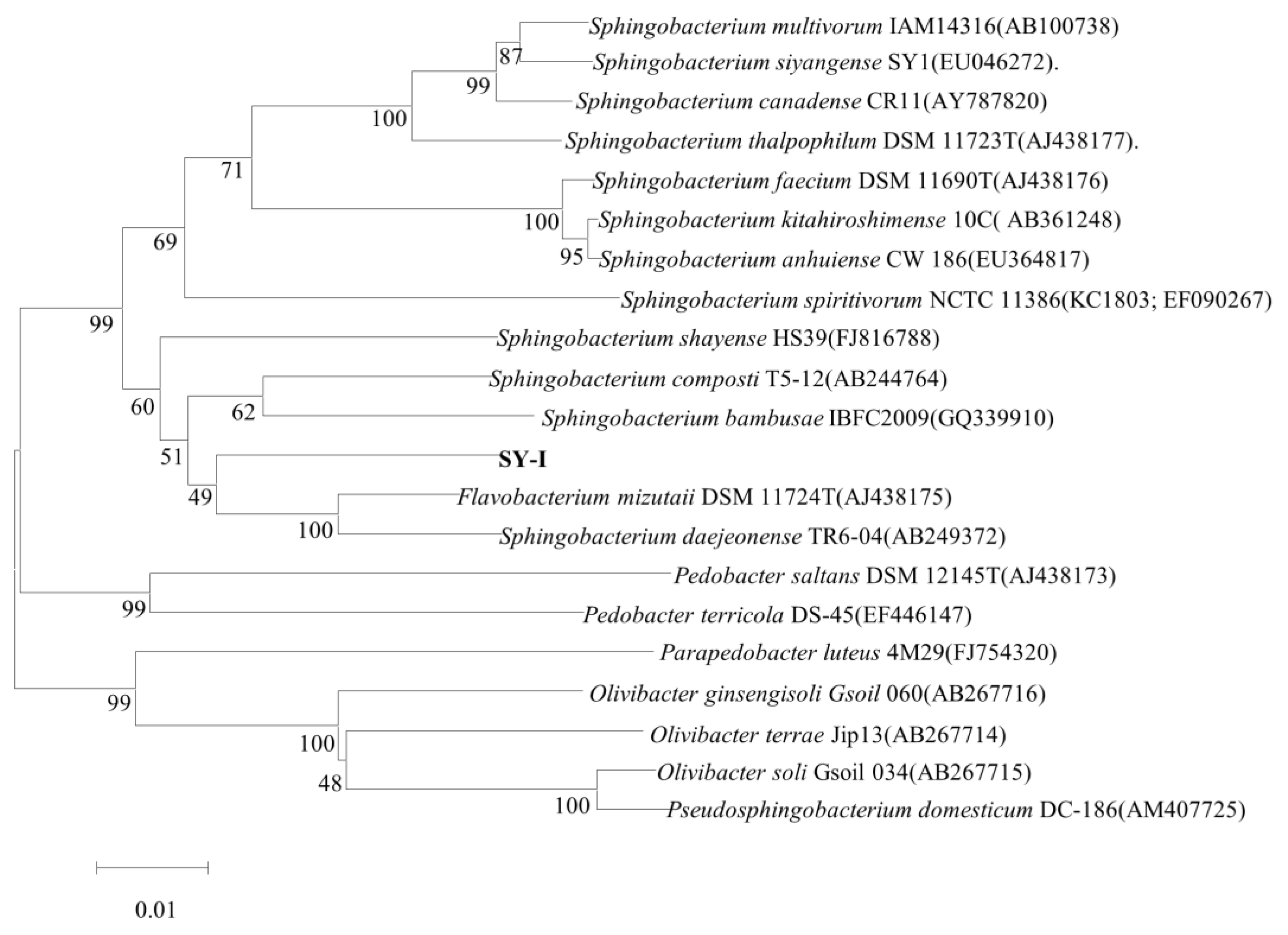
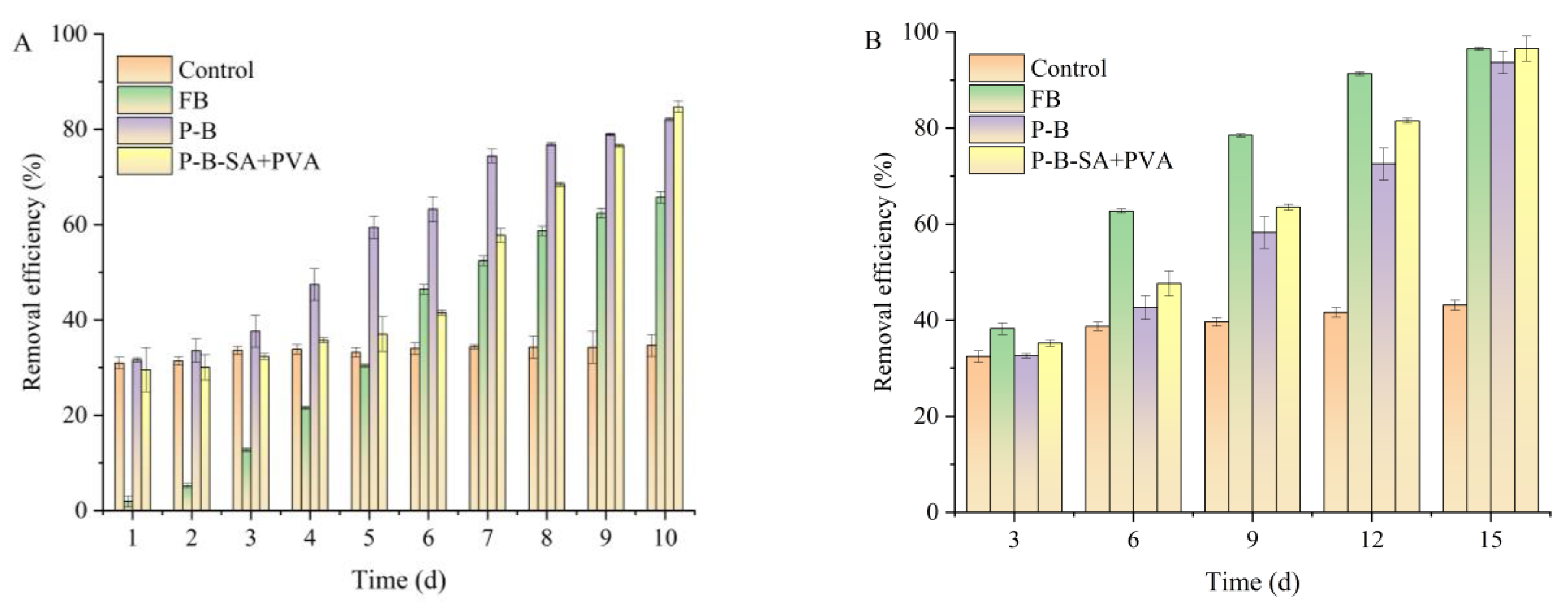
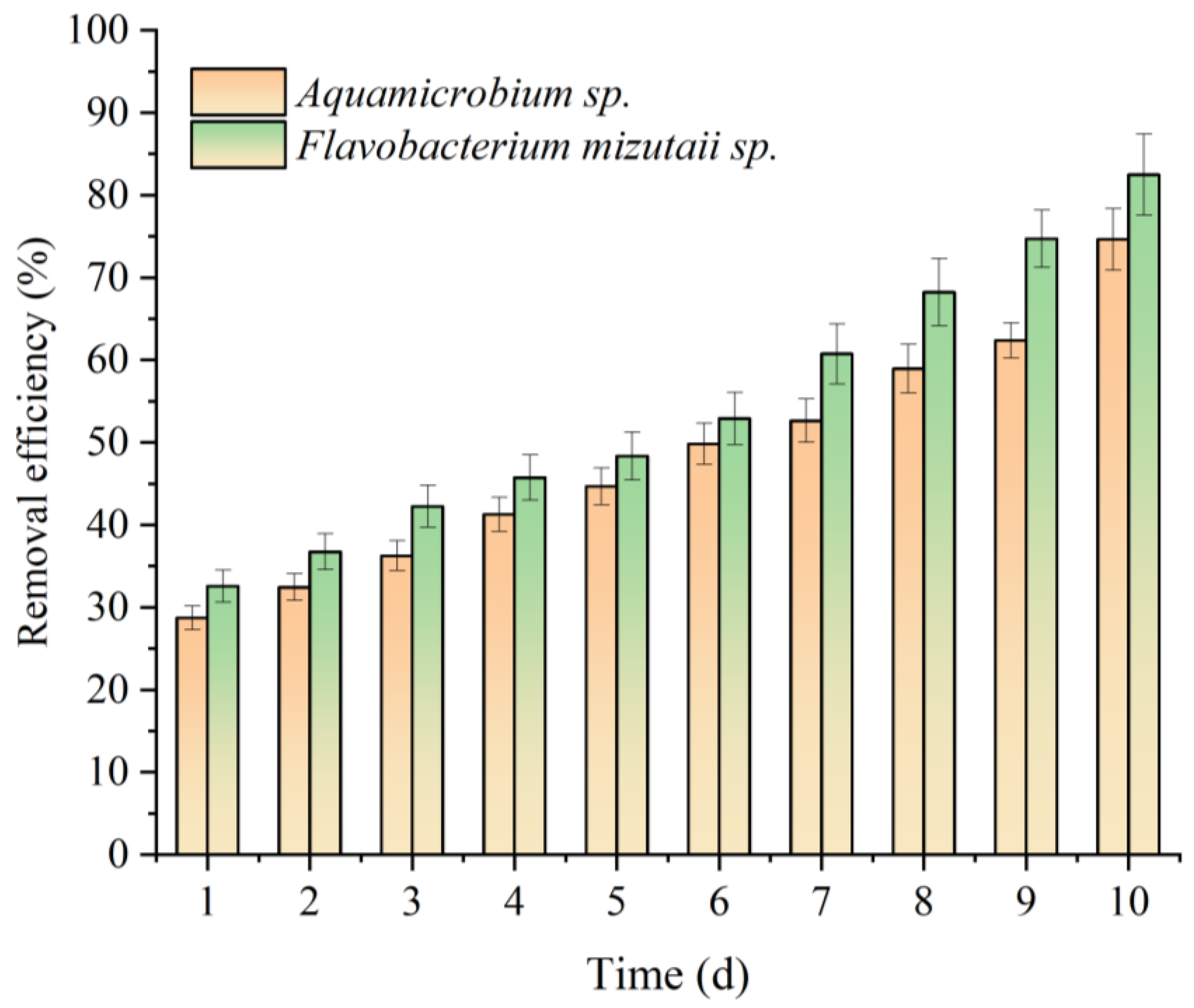
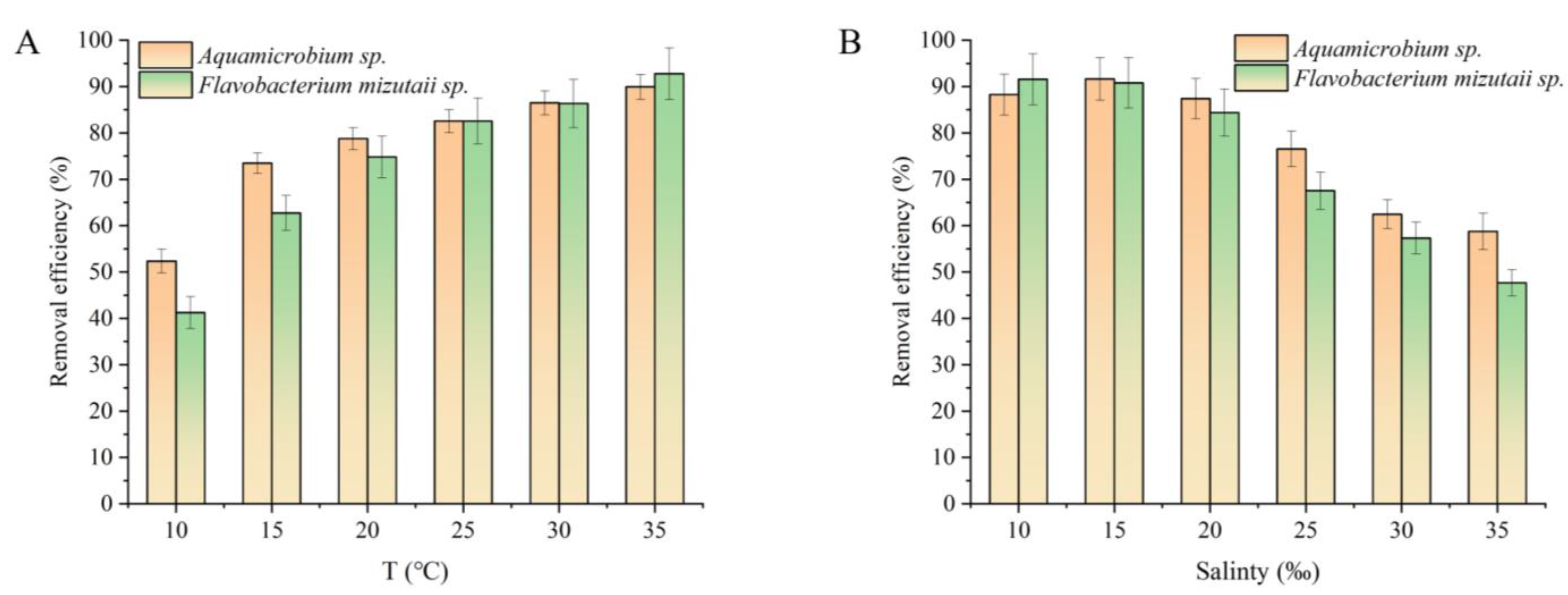
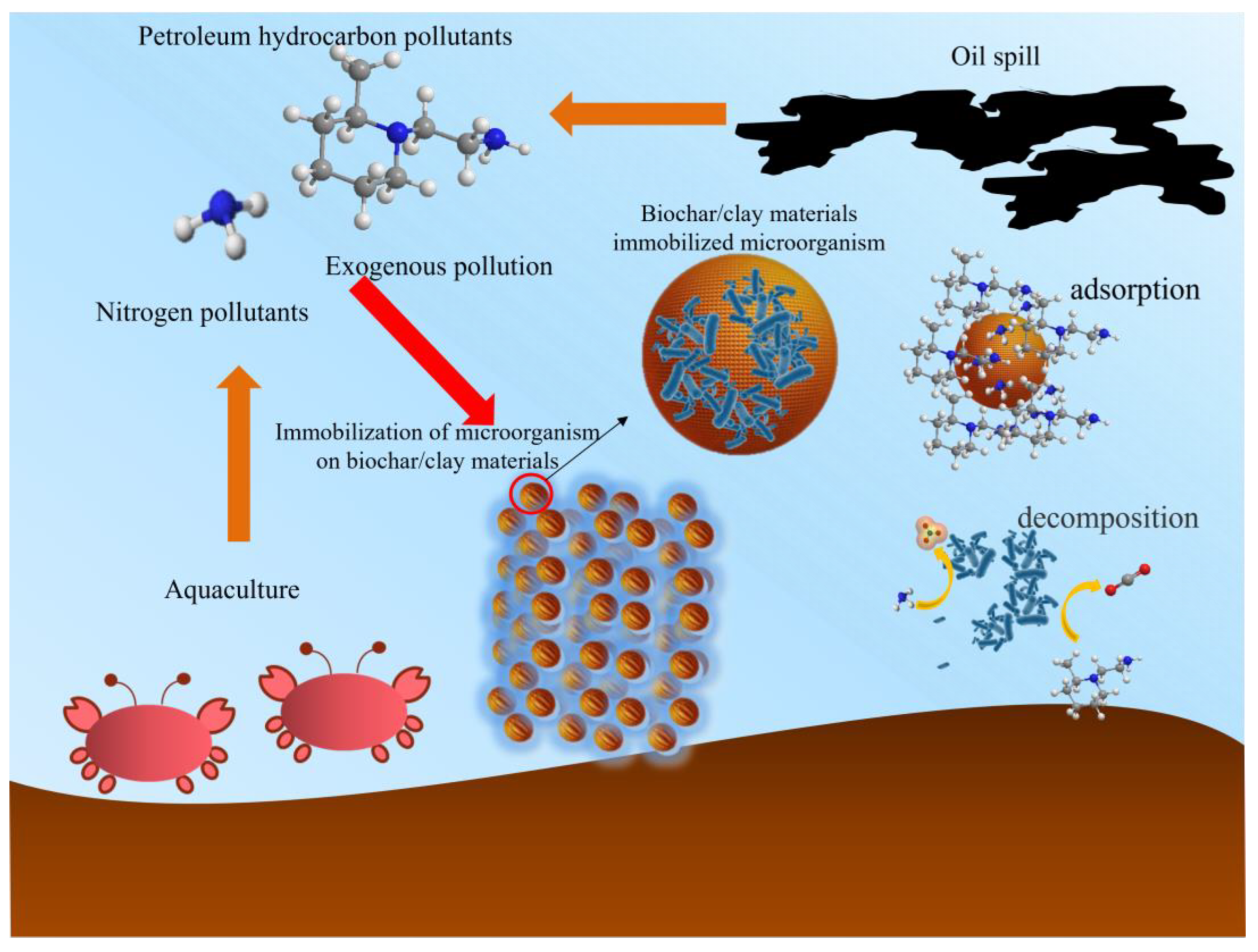
| Number. | Biochar Dosage (%) | Na2SiO3 Dosage (%) | NaHCO3 Dosage (%) |
|---|---|---|---|
| 1 | 5 | 1 | 1 |
| 2 | 5 | 2 | 2 |
| 3 | 5 | 3 | 3 |
| 4 | 10 | 1 | 2 |
| 5 | 10 | 2 | 3 |
| 6 | 10 | 3 | 1 |
| 7 | 15 | 1 | 3 |
| 8 | 15 | 2 | 1 |
| 9 | 15 | 3 | 2 |
| No. of Strains | Catalase Test | Starch Hydrolysis Test | Citrate Test | MR Test | Glucose Oxidation Fermentation Test | VP Test | Indole Test |
|---|---|---|---|---|---|---|---|
| HXN-2 | + | + | − | + | − | − | + |
| SY-I | − | − | − | + | − | + | + |
| Levels | Biochar Dosage (%) | Na2SiO3 Dosage (%) | NaHCO3 Dosage (%) | Result |
|---|---|---|---|---|
| A | B | C | Adsorption Capacity (mg/g) | |
| 1 | 5 | 1 | 1 | 0.452 |
| 2 | 5 | 2 | 2 | 0.463 |
| 3 | 5 | 3 | 3 | 0.484 |
| 4 | 10 | 1 | 2 | 0.487 |
| 5 | 10 | 2 | 3 | 0.495 |
| 6 | 10 | 3 | 1 | 0.491 |
| 7 | 15 | 1 | 3 | 0.538 |
| 8 | 15 | 2 | 1 | 0.521 |
| 9 | 15 | 3 | 2 | 0.526 |
| Average value 1 | 0.466 | 0.492 | 0.488 | 0.506 |
| Average value 2 | 0.491 | 0.493 | 0.492 | |
| Average value 3 | 0.528 | 0.500 | 0.506 |
| Levels | Factor | ||||
|---|---|---|---|---|---|
| δ1 | δ2 | δ3 | R | T | |
| 1 | δ11 = −0.029 | δ21 = −0.003 | δ31 = −0.007 | R01 = −0.003 | 0.026 |
| R11 = −0.029 | |||||
| 2 | δ12 = −0.004 | δ22 = −0.002 | δ32 = −0.003 | R02 = −0.002 | 0.002 |
| R12 = −0.004 | |||||
| 3 | δ13 = 0.033 | δ23 = 0.005 | δ33 = 0.011 | R03 = 0.033 | 0.028 |
| R13 = 0.005 | |||||
| Primary relation | CAB | ||||
| Optimal scheme | A3B3C3 (15% – 3% – 3%) | ||||
| Pseudo-First-Order | Pseudo-Second-Order | Intra-Particle Diffusion | |||||||
|---|---|---|---|---|---|---|---|---|---|
| qe | K−1 | qeq | R2 | K2 | qeq | R2 | kp | R2 | |
| (mg/g) | (min−1) | (mg/g) | (g/mg min) | (mg/g) | (g/mg min0.5) | ||||
| 5% | 0.450 | 0.036 | 0.455 | 0.929 | 0.093 | 0.513 | 0.986 | 0.024 | 0.944 |
| 10% | 0.482 | 0.036 | 0.469 | 0.939 | 0.088 | 0.530 | 0.991 | 0.025 | 0.944 |
| 15% | 0.518 | 0.039 | 0.495 | 0.916 | 0.092 | 0.557 | 0.983 | 0.026 | 0.945 |
| Pseudo-First-Order | Pseudo-Second-Order | Intra-Particle Diffusion | |||||||
|---|---|---|---|---|---|---|---|---|---|
| qe | K−1 | qeq | R2 | K2 | qeq | R2 | kp | R2 | |
| (mg/g) | (min−1) | (mg/g) | (g/mg min) | (mg/g) | (g/mg min0.5) | ||||
| 1.0% | 0.395 | 0.035 | 0.370 | 0.877 | 0.117 | 0.414 | 0.959 | 0.019 | 0.960 |
| 2.0% | 0.404 | 0.029 | 0.385 | 0.899 | 0.091 | 0.435 | 0.953 | 0.021 | 0.961 |
| 3.0% | 0.411 | 0.039 | 0.394 | 0.934 | 0.121 | 0.440 | 0.985 | 0.020 | 0.928 |
Disclaimer/Publisher’s Note: The statements, opinions and data contained in all publications are solely those of the individual author(s) and contributor(s) and not of MDPI and/or the editor(s). MDPI and/or the editor(s) disclaim responsibility for any injury to people or property resulting from any ideas, methods, instructions or products referred to in the content. |
© 2023 by the authors. Licensee MDPI, Basel, Switzerland. This article is an open access article distributed under the terms and conditions of the Creative Commons Attribution (CC BY) license (https://creativecommons.org/licenses/by/4.0/).
Share and Cite
Sun, P.; Wei, J.; Gao, Y.; Zhu, Z.; Huang, X. Biochar/Clay Composite Particle Immobilized Compound Bacteria: Preparation, Collaborative Degradation Performance and Environmental Tolerance. Water 2023, 15, 2959. https://doi.org/10.3390/w15162959
Sun P, Wei J, Gao Y, Zhu Z, Huang X. Biochar/Clay Composite Particle Immobilized Compound Bacteria: Preparation, Collaborative Degradation Performance and Environmental Tolerance. Water. 2023; 15(16):2959. https://doi.org/10.3390/w15162959
Chicago/Turabian StyleSun, Pengfei, Jun Wei, Yaoyao Gao, Zuhao Zhu, and Xiao Huang. 2023. "Biochar/Clay Composite Particle Immobilized Compound Bacteria: Preparation, Collaborative Degradation Performance and Environmental Tolerance" Water 15, no. 16: 2959. https://doi.org/10.3390/w15162959
APA StyleSun, P., Wei, J., Gao, Y., Zhu, Z., & Huang, X. (2023). Biochar/Clay Composite Particle Immobilized Compound Bacteria: Preparation, Collaborative Degradation Performance and Environmental Tolerance. Water, 15(16), 2959. https://doi.org/10.3390/w15162959








